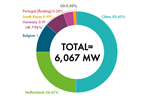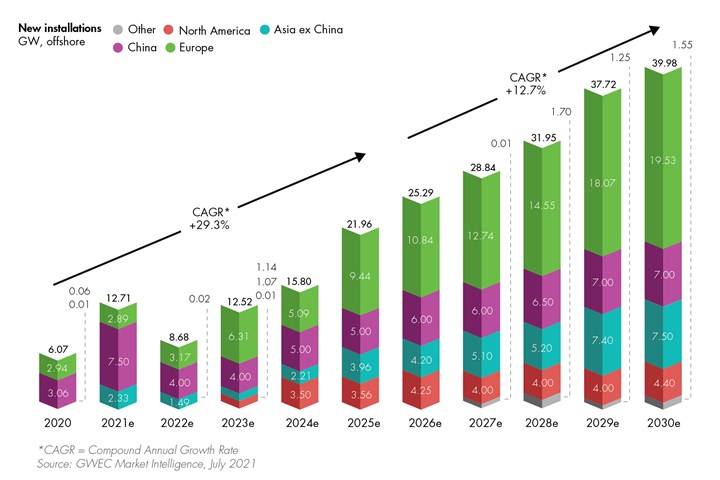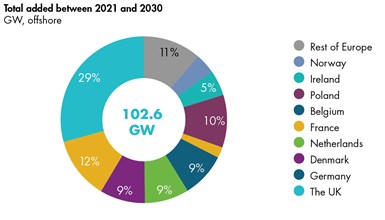Global Offshore Wind Report 2021 forecasts 235 GW installed over next decade
Though the forecasted new offshore wind capacity is seven times larger than the current market size, it’s only 2% of what’s needed for zero-emission targets, GWEC says.
This chart indicates offshore wind installations 2020-2030 globally. Photo Credit, all images: GWEC Market Intelligence, July 2021
On Sept. 9 the Global Wind Energy Council (GWEC, Brussel, Belgium) released the third edition of its annual flagship Global Offshore Wind Report. The report found that offshore wind capacity grew steadily in 2020, with 6.1 gigiwatts (GW) installed globally, but governments will need to act decisively to improve policy in order to scale up installations at the pace required to help the world meet its carbon emissions targets and avoid the worst effects of climate change. These conclusions are similar to GWEC’s last report in April).
The report highlights offshore wind’s role in the decades ahead as one of the central planks of the world’s future energy system on the road to net zero, the latest technology innovations to open new opportunities for the sector and how the offshore wind industry is powering a green recovery and just transition.
GWEC points out these key highlights from the report:
- Led by China, the world installed 6.1 GW of offshore wind in 2020
- 2020 was the second highest year for offshore wind installations despite COVID-19 disruptions, following a record year in 2019
- Offshore wind has the biggest growth potential of any renewable energy technology but the policy environment needs to improve rapidly for offshore wind to reach international net-zero targets
- Offshore wind today is only 2% of what the world needs to get to net zero by 2050
- The report forecasts 235 GW of new offshore wind capacity will be installed over the next decade under current policies. That capacity is seven times bigger than the current market size, and is a 15% increase on the previous year’s forecasts
- A growing group of countries have identified offshore wind as a key technology for reaching climate targets, but governments now need to follow up on commitments and work with industry to allow investment to scale up rapidly.
Download the full report.
Related Content
-
MingYang reveals 18-MW offshore wind turbine model with 140-meter-long blades
The Chinese wind turbine manufacturer surpasses its 16-MW platform, optimizes wind farm construction costs for 1-GW wind farms.
-
Collins Aerospace to lead COCOLIH2T project
Project for thermoplastic composite liquid hydrogen tanks aims for two demonstrators and TRL 4 by 2025.
-
Recycling end-of-life composite parts: New methods, markets
From infrastructure solutions to consumer products, Polish recycler Anmet and Netherlands-based researchers are developing new methods for repurposing wind turbine blades and other composite parts.












.jpg;maxWidth=300;quality=90)

